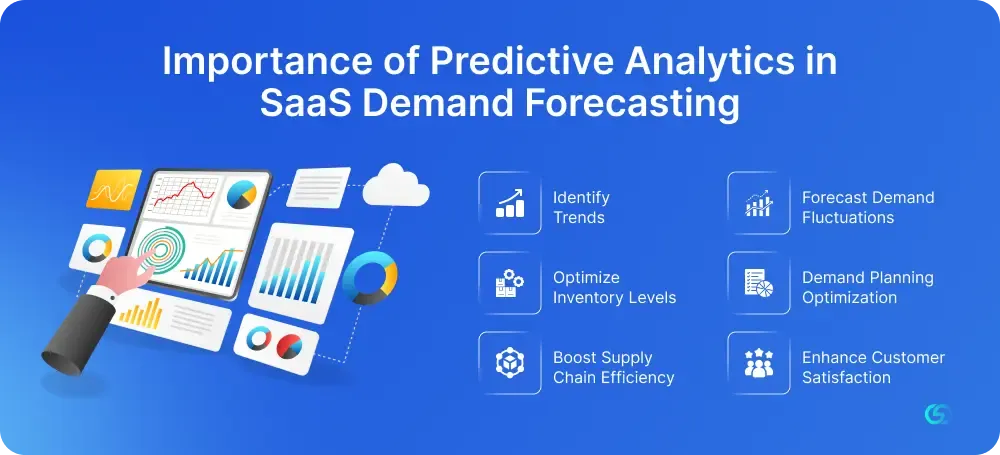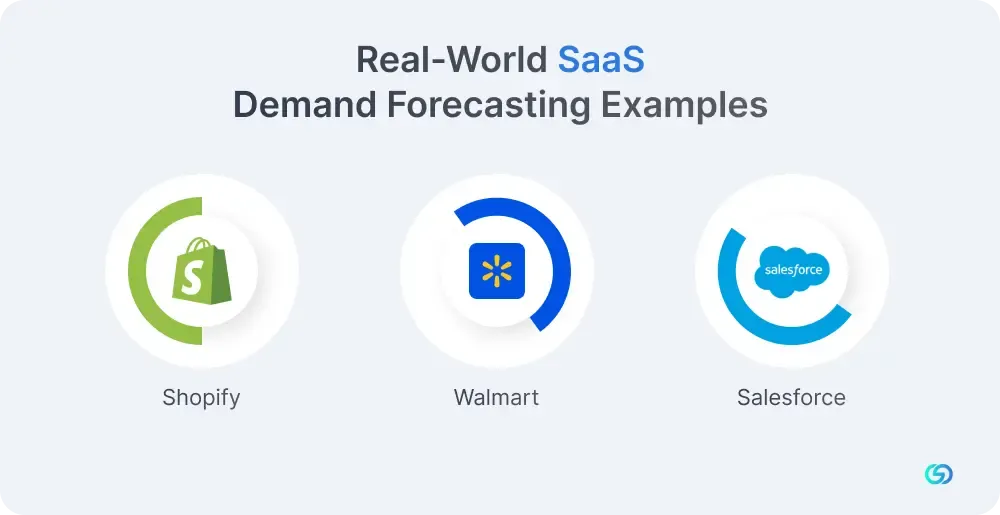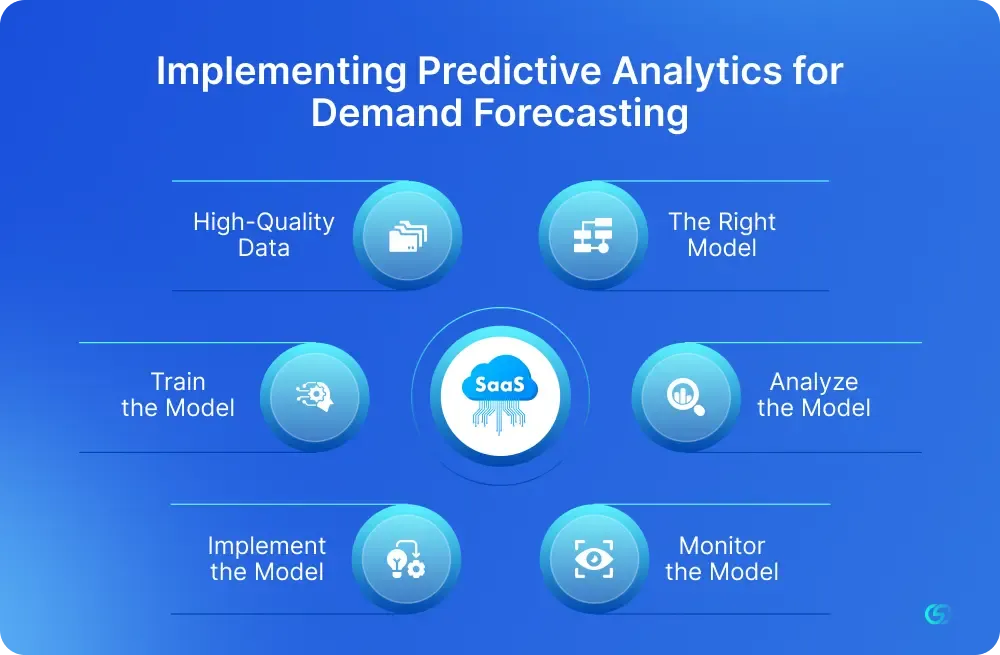- Predictive Analytics For SaaS Demand Forecasting
- 2025-07-18
How Predictive Analytics in SaaS Drives Accurate Demand Forecasting?

Audio Track
Table of Contents
Key Takeaways:
- By forecasting demand using predictive analytics, businesses reduce risks, cut costs, and make smarter, faster decisions.
- The global market for predictive analytics is estimated to reach $28B by 2026.
- Giants like Shopify, Salesforce, and Walmart leverage predictive analytics to optimize inventory, improve customer experience, and enhance workflow.
- Predictive analytics in SaaS drives data-backed growth across industries with real-time insights, hyper-personalization, and automated decisions.
The Rise of Predictive Analytics
Wouldn’t it be powerful if your business could predict customer behavior and stay ahead of market trends?
This might change your business operations entirely!
Predictive analytics transform processes by allowing businesses to make critical decisions, eliminate risks, and optimize resources.
Predictive analytics is an essential component in the way modern businesses are conducted. According to statistics, the global market is expected to reach $28 billion by 2026, growing at a CAGR of 21.7%. This surge in adoption is mainly driven by the increasing need for businesses to reduce costs and make informed decisions across industries.
In the context of SaaS, demand planning and forecasting play a crucial role in driving business growth and staying competitive. By accurately predicting market demand, companies can change how they manage inventory, align sales strategies, and respond to the dynamic customer demands in today’s fast-paced digital environment.
Role of Demand Planning and Forecasting
Let’s understand demand planning and forecasting.
Demand planning is a process that uses forecasted demand to sync inventory, optimize resources, and ensure the supply chain operates smoothly.
Heavily driven by data, demand planning also depends on professional experience and judgement. It interprets data, reads the market, and helps in making strategic decisions to meet customer demands.
Human touch is crucial in demand planning. Leveraging cutting-edge software and statistical models help gather insights, adjust strategies, and develop scenarios for market changes.
On the other hand, demand forecasting is about anticipating future customer demand based on a product or service. It offers a glimpse into the future of sales patterns by utilizing historical data and analyzing the market.
With the help of advanced technology, demand forecasting has transformed the way it is conducted. The system used today harnesses vast datasets, using algorithms, and ML to make predictions.
Both demand planning and forecasting are crucial to attain a competitive edge.
What is the Importance of Predictive Analytics in SaaS for Demand Forecasting?

Predictive analytics is a revolutionary solution for Software-as-a-Service (SaaS) businesses, leveraging real-time and historical data to predict customer behaviors and future trends. AI, machine learning, and statistical modelling are some of the techniques it integrates to generate actionable insight, allowing businesses to boost user interactions and tailor product offerings with strategic decisions.
Predicitve analytics in SaaS is growing rapidly due to the expansion of cloud computing and the increase in access to AI tools. With demand forecasting using AI becoming an important SaaS strategy, it is transforming businesses and helping them compete more easily.
Predictive analytics uses advanced models and machine learning algorithms, and this helps the businesses to:
1. Identify Trends
By using predictive analytics, businesses can anticipate shifts in demand by identifying trends, patterns, and seasonal variations. This allows smarter planning and faster response to market changes.
2. Forecast Demand Fluctuations
Predictive analytics support accurate demand planning and forecasting by helping businesses analyze historical data to predict demand fluctuations. This allows for better inventory control, staffing, and resource allocation.
3. Optimize Inventory Levels
With predictive models, your business can determine if the inventory is aligned with what is trending and in demand. This minimizes the risk of overstocking or understocking.
4. Demand Planning Optimization
Did you know? About 34% of businesses shipped orders late as they sold items that were out of stock. Demand planning optimization process uses data analysis, forecasting techniques, and technology to accurately predict future product or service demand. This allows businesses to improve customer satisfaction and optimize inventory levels.
5. Boost Supply Chain Efficiency
You can improve demand planning and forecasting accuracy with predictive analytics and optimize supply chain operations. This will result in lower costs and better efficiency.
6. Enhance Customer Satisfaction
Leveraging predictive analytics ensures that the products are always available when needed. This boosts the customer’s experience and increases brand loyalty.
Real-World Examples of Predictive Analytics in SaaS for Demand Forecasting

Predictive analytics for SaaS for demand forecasting leverages historical data and machine learning to anticipate future product demand, optimizing inventory, pricing, and marketing strategies. The following are some real-world examples to help you understand the impact of it.
🔹 Shopify
Shopify helps online merchants predict which products are likely to trend by analyzing historical sales, seasonal behavior, and customer preferences. This enables better inventory planning and smarter marketing strategies for businesses.
🔹 Walmart
Leverages predictive analytics to optimize supply chains, manage inventory, and personalize the customer experience. This helps them minimize stockouts and reduce excess inventory. Predictive analytics is a cornerstone in Walmart's strategy to optimize its operations.
🔹 Salesforce
Salesforce uses predictive analytics in SaaS for demand forecasting, allowing businesses to forecast future needs and optimize their workflow. With its AI engine, Einstein, Salesforce supports demand forecasting using AI to get an understanding of sales trends, lead conversions, and customer churn. This gives the sales team the insight needed to plan resources more effectively.
How to Implement Predictive Analytics for Demand Forecasting?

To get the most out of predictive analytics for demand forecasting, following best practices is essential. Here’s how to go about it:
-
High-Quality Data: Utilizing data that is accurate, relevant, and high-quality is quite important.
-
The Right Model: Make sure you select the right model for predictive analytics that is appropriate for the data and issues.
-
Train the Model: It is crucial to train and test the predictive analytics model using a section of the data to assess performance.
-
Analyze the Model: Using various metrics such as precision, accuracy, and recall, assess the predictive analytics model’s performance.
-
Implement the Model: Launch the predictive analytics model and integrate it with the current systems.
-
Monitor the Model: It’s crucial to keep an eye on the performance of the predictive analytics model and regularly update it to ensure it remains effective and accurate.
Application of Predictive Analytics in SaaS for Demand Forecasting Across Industries

The use of predictive analytics in SaaS isn’t just limited to one niche but plays an impactful role in various industries. With demand planning and forecasting, businesses remain better equipped to predict trends, manage resources, and respond to market needs.
▶ Retail and E-Commerce
Predictive analytics in SaaS is transforming the e-commerce industry by offering foresight to predict customer needs, manage inventory smartly, and personalize shopping experiences. In the retail and e-commerce industry, predictive analytics uses purchase history and user behavior to enhance the user experience. SaaS platforms like BigCommerce and Shopify integrate these features directly for smarter inventory planning.
▶ Manufacturing
Many manufacturers rely on SaaS tools with built-in demand forecasting to align production schedules with expected market demand. This reduces waste, streamlines supply chains, and offers a better delivery schedule.
▶ Healthcare
Predictive analytics in the SaaS platform is transforming demand forecasting in the healthcare industry. This system helps forecast patient volumes, medication demand, and more. SaaS solutions in this space leverage AI in demand forecasting to prep hospitals and medical centers for seasonal spikes and emergencies.
▶ Logistics and Transportation
According to McKinsey, AI demand forecasting lowers supply chain errors by 20% to 50%. Predictive analytics reduces lost sales and stock shortages by up to 65%. With the help of SaaS platforms in logistics, you can forecast shipment volumes, optimize fleet management, and ensure timely deliveries.
▶ Hospitality and Travel
The travel and hospitality industry prioritizes timing, pricing, and customer preferences. With huge demands influenced by seasons, events, and global trends, businesses are turning to predictive analytics in SaaS to overcome the bottlenecks. With demand forecasting using AI, airlines and hotels can predict high and low booking periods, adjust pricing, and plan resource allocation.
Future of Predictive Analytics in SaaS
For businesses looking to advance demand forecasting and planning, predictive analytics on the SaaS platform is essential. With well-informed and smarter decisions, companies can boost operational performance and customer happiness with timely stock availability.
When it comes to the future of predictive analytics in SaaS, it’s not just promising but inevitable. With industries continuing to prefer data-driven decisions, predictive tools will become more advanced and integrated in everyday operations.
SaaS platforms are expected to deliver more personalized predictions with the adoption of AI in demand forecasting. This will help businesses stay ahead of the changing customer behaviors.
What lies ahead is:
- Hyper-personalization
- Automated decision-making
- Industry-specific deeper insights
- Integration with real-time economic indicators
- Smarter partnership between teams
ConvexSol’s demand forecasting solutions utilize predictive analytics to increase efficiency across diverse sectors. Our experts assist businesses with powerful insights to precisely forecast customer needs by implementing historical sales data and real-time indicators. We handle technical complexities and provide continuous SaaS support with end-to-end performance monitoring and regular updates.
Predictive analytics in SaaS helps businesses not just respond to changes but anticipate and lead them.

